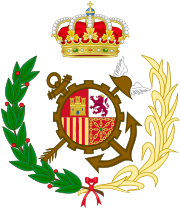Servicio de Vigilancia Aduanera
|
|||
|---|---|---|---|
| State level | State level | ||
| Position of the authority | Customs and border police | ||
| Supervisory authority (s) | Ministerio de Hacienda (Spanish Ministry of Finance) | ||
| Consist | since 1887 | ||
| Headquarters | Avenida Llano Castellano 17, Madrid | ||
| Employee | 1,894 (2010) | ||
| Website | agenciatributaria.es ( Memento of July 14, 2014 in the Internet Archive ) | ||
The Servicio de Vigilancia Aduanera ( Spanish for Customs Surveillance Service) is a Spanish customs and border police which, as part of the tax and customs authority ( Agencia Estatal de Administración Tributaria ), is subordinate to the Spanish Ministry of Finance ( Ministerio de Hacienda y Administraciones Públicas ). The main tasks include tracking down smuggling and white-collar crime .
history
The origins of today's Servicio de Vigilancia Aduanera go back to the 18th century, when the Kingdom of Spain protected the monopolized trade in tobacco with paramilitary organizations, the so-called Resguardos, in order to prevent smuggling. In 1887 the Compañía Arrendataria de Tabacos was created to administer the state tobacco monopoly . In 1944, the organization became part of the state tobacco company Tabacalera , the law enforcement agency subordinate to this was named Servicio Especial de Vigilancia Marítima y Terrestre de Tabacalera SA (Special Service for Sea and Land Surveillance of Tabacalera SA). In 1954, the Spanish Ministry of Finance took over the authority of the border and customs police under the name Servicio Especial de Vigilancia Fiscal . After a structural reform in 1982, this was finally given the current name Servicio de Vigilancia Aduanera .
Tasks and organization
The tasks of the Servicio de Vigilancia Aduanera are the prosecution and fight against smuggling on the entire Spanish national territory including the airspace and the territorial waters as well as the investigations, controls and prosecutions commissioned by the tax and customs authorities in the field of money laundering , black economy and other White-collar crime .
The Servicio de Vigilancia Aduanera is headed by a Deputy Director of Customs Control ( Dirección Adjunta de Vigilancia Aduanera , DAVA) based in Madrid . This is part of the Department for Customs and Special Taxes ( Departamento de Aduanas e Impuestos Especiales ) of the Spanish tax and customs authority Agencia Estatal de Administración Tributaria (AEAT).
The SVA bases are divided into:
- Servicios Centrales (Headquarters, Madrid)
- Áreas Regionales (one per autonomous community )
These in turn are divided into:
- Unidades Operativas (investigative staff)
- Unidades Combinadas (investigation and ship personnel)
- Bases Marítimas (25 sea bases along the Spanish coast)
- Destacamentos Aéreos (air bases)
equipment
Air and sea vehicles
Since Spain has a coastline of 7,876 km and is one of the most important entry gates for drugs, especially hashish and cocaine , by sea , one of the main tasks of the Servicio de Vigilancia Aduanera is the surveillance of Spanish waters. Almost half of the approximately 1,900 employees work in the area of maritime border control. For this purpose, the authority has 18 speedboats available, which, depending on the class, reach top speeds of 45 to 60 knots . In addition, the SVA operates four coastal and 17 deep-sea patrol boats. With the Petrel I (72.5 m length) and the Fulmar (61 m), the SVA also has two larger ships equipped with a helicopter deck, which are used in particular for special missions on the high seas.
The Servicio de Vigilancia Aduanera operates six helicopters for air surveillance, three of which are Bölkow Bo 105s , two Dauphin N3s and one MBB / Kawasaki BK 117 . In addition, the authority has six CASA C-212s specially equipped for maritime surveillance . The SVA's 24-hour flight standby for air surveillance are stationed at the following bases: Base Aérea de Morón (Seville), Base Aérea de San Javier (Murcia) and Aeródromo Militar de Santiago (La Coruña).
Other equipment
The SVA has a fleet of around 500 vehicles, including cars, vans, off-road vehicles, trucks and motorcycles. These usually have a dark blue finish with light blue lettering. In addition, six mobile cargo scanners from Smiths Heimann GmbH and Nuctech are used. These are mainly stationed in the country's largest ports and enable non-destructive testing of ISO containers and trucks. The service weapons of the officials of the Servicio de Vigilancia Aduanera are pistols of the model HK USP Compact and HK MP5 submachine guns. MG3 and Browning M2 are sometimes installed on watercraft .
Nissan Pathfinder III of the SVA.
Individual evidence
- ↑ a b c Navies and Maritime Security Enforcement Agencies: models for cooperation. (PDF; 2.13 MB) In: defensa.gob.es. January 29, 2010; Archived from the original on November 21, 2011 ; Retrieved June 11, 2014 (Spanish).
- ↑ La Compañía Arrendataria de Tabacos. In: vidamaritima.com. November 18, 2007, accessed June 11, 2014 (Spanish).
- ↑ Real Decreto 319/1982, de 12 de February, por el que se reestructura y adscribe directamente el Servicio de Vigilancia Aduanera. In: boe.es. February 25, 1982, Retrieved June 12, 2014 (Spanish).
- ↑ Ley Orgánica 12/1995, de 12 de diciembre, de Represión del Contrabando. In: boe.es. December 13, 1995. Retrieved June 12, 2014 (Spanish).
- ↑ Abordaje en alta mar. In: El País . June 3, 2013, Retrieved June 11, 2014 (Spanish).
Web links
- Official website (English, Spanish)
literature
- Fabian Hinrichs: The law of the Spanish law enforcement police. Ergon-Verlag, Würzburg 2004, ISBN 3-89913-364-1 ( Würzburg juridical writings 51), (Also: Würzburg, Univ., Diss., 2004).











